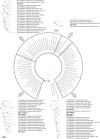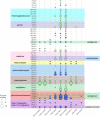Selective enrichment on a wide polysaccharide spectrum allowed isolation of novel metabolic and taxonomic groups of haloarchaea from hypersaline lakes
- PMID: 36504804
- PMCID: PMC9726719
- DOI: 10.3389/fmicb.2022.1059347
Selective enrichment on a wide polysaccharide spectrum allowed isolation of novel metabolic and taxonomic groups of haloarchaea from hypersaline lakes
Abstract
Extremely halophilic archaea (haloarchaea) of the class Halobacteria is a dominant group of aerobic heterotrophic prokaryotic communities in salt-saturated habitats, such as salt lakes and solar salterns. Most of the pure cultures of haloarchaea were enriched, isolated, and cultivated on rich soluble substrates such as amino acids, peptides or simple sugars. So far, the evidences on the capability of haloarchaea to use different polysaccharides as growth substrates remained scarce. However, it is becoming increasingly obvious that these archaea can also actively participate in mineralization of complex biopolymers, in particular cellulose and chitin-two dominant biomass polysaccharides on the planet. Here we used an array of commercially available homo- and heteropolysaccharides to enrich hydrolytic haloarchaea from hypersaline salt lakes with neutral pH and from alkaline soda lakes. This resulted in isolation of a range of halo- and natrono-archaea, respectively, belonging to already described taxa as well as several new genus-level lineages. In some cases, the isolates enriched with different polysaccharides happened to be closely related, thus representing generalistic ecotype, while the others were narrow specialists. In general, soda lakes yielded a broader range of polysaccharide-utilizing specialists in comparison to neutral salt lakes. The results demonstrated a significant diversity of halo(natrono)archaea with a previously unrecognized potential for utilization of a broad range of natural polysaccharides in hypersaline habitats.
Keywords: halo(natrono)archaea; hydrolytic; hypersaline lakes; polysaccharides; soda lakes.
Copyright © 2022 Sorokin, Elcheninov, Khijniak, Kolganova and Kublanov.
Conflict of interest statement
The authors declare that the research was conducted in the absence of any commercial or financial relationships that could be construed as a potential conflict of interest.
Figures




References
-
- Begemann M. B., Mormile M. R., Paul V. G., Vidt D. J. (2011). “Potential enhancement of biofuel production through enzymatic biomass degradation activity and biodiesel production by halophilic microorganisms,” in Halophiles and hypersaline environments: Current research and future trends, eds Ventosa A., Oren A., Ma Y. (Heidelberg: Springer; ), 341–357.
-
- Bhatnagar T., Boutaiba S., Hacene H., Cayol J.-L., Fardeau M.-L., Ollivier B., et al. (2005). Lipolytic activity from halobacteria: Screening and hydrolase production. FEMS Microbiol. Lett. 248 133–140. - PubMed
LinkOut - more resources
Full Text Sources
Molecular Biology Databases
Research Materials

